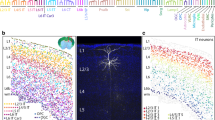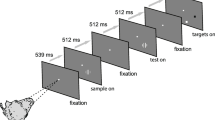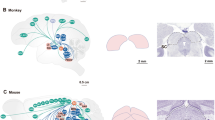Summary
-
1.
Changes in unit activity during the transcallosal response (TCR) consist essentially of four types: 1) a spike discharge during the TCR, 2)a spike discharge during the TCR and an after-discharge 200–400 msec later, 3) a spike discharge during the TCR and temporary cessation of spike activity, 4) temporary cessation of spike activity. These response types are determined by alternation of depolarization and hyperpolarization on the cell membranes and by the frequency of the initial spontaneous activity.
-
2.
Spike responses during the TCR appear after 1.4–59.2 msec. Approximately 50% of the responding neurons (of which about 10% are activated antidromically) do so in the first 10–12 msec, corresponding to the positive phase of the TCR. The remaining neurons start their spike activity in the subsequent negative phase of the TCR, lasting about 50 msec. Alternation of phases of the TCR can evidently be attributed to depolarization followed by hyperpolarization of single units.
-
3.
Most neurons of the primary somatosensory cortex which send axons (or their collaterals) into the symmetrical area of the opposite cortex respond to nerve stimulation not sooner than 6 msec after arrival of the peripheral impulses in the cortex, i.e., after additional intracortical relays. Only a few neurons in layer VI transmit a peripheral signal rapidly to the opposite hemisphere. The earliest stable afferent connection with the opposite hemisphere is formed by neurons in layer III. Among neurons participating later in the TCR, a high proportion consists of neurons of the pyramidal tract.
Similar content being viewed by others
References
BYKOV, K. M. Selected Works, Vol. 1, Moscow, 1953, p. 11 and 13.
STOROZHUK, V. M. Fiziol. Zh. SSSR im I. M. Sechenova. 52:1169, 1966.
ASANUMA, H. Jap. J. Physiol. 9:94, 1959.
ASANUMA, T. and O. OKUDA. J. Neurophysiol. 25:198, 1962.
BURES, J. In: The Central Nervous System and Behavior. New York, 1959, p., 207.
CHANG, H. T. J. Neurophysiol. 16:117, 1953.
CURTIS, H. J.. J. Neurophysiol. 3:405, 1940.
EBNER, F. and R. MYERS. J. Neurophysiol. 25:380, 1962.
GRAFSTEIN, B. J. Neurophysiol. 22:504, 1959.
GRAFSTEIN, B. J. Neurophysiol. 26:79, 1963.
LATIMER, C. and T. KENNEDY. J. Neurophysiol. 24:79, 1961.
MEIKLE, T., J. A. SECHZER and E. STELLAR. J. Neurophysiol. 25:530, 1962.
NAUTA, W.: Anat. Rec. 118:333, 1954.
PEACOCK, S. M. J. Neurophysiol. 20:140, 1957.
TERZUOLO, C. and W. ADEY. In: Handbook of Physiology, Vol. 2. Washington, 1960.
TOWE, A. L., H. D. PATTON and T. KENNEDY. Exp. Neurol. 8μ:220, 1963.
Author information
Authors and Affiliations
Rights and permissions
About this article
Cite this article
Storozhuk, V.M. Unit activity of the primary somatosensory cortex during transcallosal response. Neurosci Behav Physiol 2, 885–893 (1968). https://doi.org/10.1007/BF01124736
Issue Date:
DOI: https://doi.org/10.1007/BF01124736




